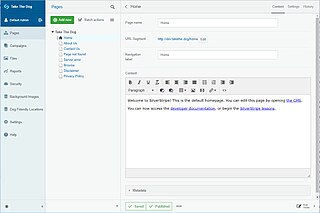
Tiki Wiki CMS Groupware or simply Tiki, originally known as TikiWiki, is a free and open source Wiki-based content management system and online office suite written primarily in PHP and distributed under the GNU Lesser General Public License (LGPL-2.1-only) license. In addition to enabling websites and portals on the internet and on intranets and extranets, Tiki contains a number of collaboration features allowing it to operate as a Geospatial Content Management System (GeoCMS) and Groupware web application.

Microsoft WebMatrix is a discontinued cloud-connected website builder and HTML editor for Windows, geared towards web development. WebMatrix enables developers to build websites using built-in templates or popular open-source applications, with full support for ASP.NET, PHP, Node.js and HTML5. Microsoft developed WebMatrix for the purpose of providing web developers with coding, customization, and publishing capabilities all in one place.
BlueDragon is a ColdFusion Markup Language (CFML) engine comparable to Adobe Systems's ColdFusion. It is licensed and distributed by New Atlanta from TagServlet Ltd based in Scotland. BlueDragon is also distributed and supported by BEA Systems on their Oracle WebLogic Server server platform.

DNN Platform is a web content management system and web application framework based on the .NET Framework. It is open source and part of the .Net Foundation.

Silverstripe CMS is a free and open source content management system (CMS) and framework for creating and maintaining websites and web applications. It provides an out of the box web-based administration panel that enables users to make modifications to parts of the website, which includes a WYSIWYG website editor. The core of the software is Silverstripe Framework, a PHP Web application framework.
Entity Framework (EF) is an open source object–relational mapping (ORM) framework for ADO.NET. It was originally shipped as an integral part of .NET Framework, however starting with Entity Framework version 6.0 it has been delivered separately from the .NET Framework.

MODX is an open source content management system and web application framework for publishing content on the World Wide Web and intranets. MODX is licensed under the GPL, is written in the PHP programming language, and supports MySQL, MariaDB and Percona Server as the database. It was awarded Packt Publishing's Most Promising Open Source Content Management System in 2007.
An embedded database system is a database management system (DBMS) which is tightly integrated with an application software; it is embedded in the application. It is a broad technology category that includes:

FUDforum is a free and open-source Internet forum software, originally produced by Advanced Internet Designs Inc., that is now maintained by the user community. The name "FUDforum" is an abbreviation of Fast Uncompromising Discussion forum. It is comparable to other forum software. FUDforum is customizable and has a large feature set relative to other forum packages.

TYPO3 is a Web Content management system (CMS) written in the programming language PHP. It can run on a variety of web servers, such as Apache, Nginx, or Internet Information Services (IIS), and on many operating systems, including Linux, Microsoft Windows, FreeBSD, macOS, and OS/2. It is free and open-source software released under the GNU General Public License version 2.

C1 CMS is a free open source .NET-based web content management system.
Elcom Technology Pty Ltd is a privately held software company based in Sydney, Australia. It provides web content management, website, portal and intranet software. Elcom's primary product is elcomCMS which is built using Microsoft ASP.NET and Microsoft SQL Server. Version 11.5 of the CMS was released on February 15, 2021.

LogicalDOC is a proprietary cloud-based document management system that is designed to handle and share documents within an organization. LogicalDOC is a content repository, with Lucene indexing, Activiti workflow, and a set of automatic import procedures. The system was developed using Java technology.
ASP.NET Web Matrix, whose name was the inspiration for WebMatrix, was released in 2003 and later discontinued by Microsoft in favor of Web Developer Express, a free version of Visual Studio's web development functionality; Visual Studio is Microsoft's flagship IDE for all aspects of Visual Basic and C# coding, including ASP.NET development.
Magnolia is an open-source content management system (CMS). It is developed by Magnolia International Ltd., based in Basel, Switzerland. It is based on Content repository API for Java (JSR-283).
nopCommerce is an open-source eCommerce platform based on Microsoft's ASP.NET Core framework and MS SQL Server 2012 backend Database. It provides a catalog frontend and an administration tool backend, allowing shopping cart creation. It is available under the nopCommerce Public License V3 and officially launched in October 2008 for small to medium-sized businesses.
The Elcom Platform is a web content management and intranet portal software written in Microsoft ASP.NET and SQL Server by Elcom Technology.
ASP.NET Web Forms is a web application framework and one of several programming models supported by the Microsoft ASP.NET technology. Web Forms applications can be written in any programming language which supports the Common Language Runtime, such as C# or Visual Basic. The main building blocks of Web Forms pages are server controls, which are reusable components responsible for rendering HTML markup and responding to events. A technique called view state is used to persist the state of server controls between normally stateless HTTP requests.







